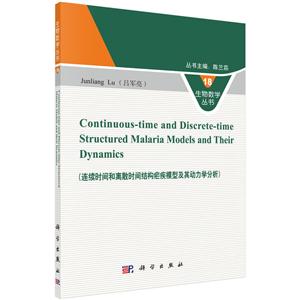扫一扫
关注中图网
官方微博
本类五星书更多>
-
>
宇宙、量子和人类心灵
-
>
考研数学专题练1200题
-
>
希格斯:“上帝粒子”的发明与发现
-
>
神农架叠层石:10多亿年前远古海洋微生物建造的大堡礁
-
>
二十四史天文志校注(上中下)
-
>
声音简史
-
>
浪漫地理学:追寻崇高景观
连续时间和离散时间结构疟疾模型及其动力学分析-18 版权信息
- ISBN:9787030482563
- 条形码:9787030482563 ; 978-7-03-048256-3
- 装帧:一般胶版纸
- 册数:暂无
- 重量:暂无
- 所属分类:>>
连续时间和离散时间结构疟疾模型及其动力学分析-18 内容简介
20世纪80年代初始,国内对“生物数学”发生兴趣的人越来越多,目前从事生物数学研究、学习生物数学的人数之多已居世界之首。为了加强交流,在“中国生物数学学会”和科学出版社的共同努力下,组织了本套《生物数学丛书》,宗旨是促进数学与生物学的相互渗透,促进数学在生物学中的应用,带动生物数学研究的发展,培养国内生物数学人才。《连续时间和离散时间结构疟疾模型及其动力学分析/生物数学丛书》为其中一册。本书的读者对象是数学和生物学相关专业高年级大学生、研究生、高校教师和科研工作者。
连续时间和离散时间结构疟疾模型及其动力学分析-18 目录
《生物数学丛书》叙PrefaceList of SymbolsChapter 1 Introduction1.1 What is malaria and its public health impact1.2 The history of malaria1.2.1 Ancient history of malaria(2700 BC-AD 340)1.2.2 Discovery of the malaria parasite1.2.3 Eradication efforts worldwide: success and failure(1955-1978)1.3 Biology and life cycle of malaria1.4 The history of mathematical malaria modeling
Chapter 2 Dynamics of continuous-time mosquito population models2.1 Introduction2.2 Continuous-time four-stage-structured mosquito population model2.3 The preliminaries2.4 The inherent net reproductive number of mosquitoes2.5 Global dynamics of the continuous-time mosquito population model2.6 Numerical examplesChapter 3 Mosquito-stage-structured malaria models and their dynamics3.1 Introduction3.2 The model formulation3.3 Positive invariant sets of the model system3.4 Infection-free equilibrium and the basic reproductive number Ro3.5 Endemic equilibria and backward bifurcation3.6 Global stability of the infection-free equilibrium3.6.1 Lyapunov function3.6.2 Global stability of the equilibrium3.7 Global stability of the endemic equilibrium3.7.1 Volterra-Goh type Lyapunov function3.7.2 Global stability of the endemic equilibriumChapter 4 Dynamics of discrete-time stage-structured mosquito population models4.1 Introduction4.2 The model formulation4.3 The inherent net reproductive number and dynamics of the trivial equilibrium4.4 The positive equilibrium4.4.1 Existence of the positive equilibrium4.4.2 The stability of the positive equilibrium4.4.3 Uniform persistence4.5 Numerical examplesChapter 5 Simple Discrete-Time Malaria Models5.1 Population dynamics for mosquitoes and humans without infection5.2 Discrete-time malaria transmission model5.3 Constant birth rate and survival rates for mosquitoes5.3.1 The infection-free equilibrium and the basic reproductiv6 number\"5.3.2 Endemic equilibria5.4 Numerical examplesChapter 6 Discrete-time mosquito-stage-structured malaria models6.1 The model formulation6.2 The infection-free fixed point and the basic reproductive number
Chapter 7 ConclusionsAppendix A Ordinary differential equationsA.1 The initial value problem for ODE systemsA.1.1 Nonautonomous systemsA.1.2 Autonomous systemsA.2 Linear systems of ODEA.2.1 General linear systemsA.2.2 Linear systems with constant coefficientsA.3 StabilityA.3.1 Stability of linear systems with constant coefficientsA.3.2 Stability by linearizationA.4 Cooperative(quasi-monotone)systemsA.4.1 Cooperative linear systemsA.4.2 Nonlinear autonomous quasi-monotone systemsA.5 Lyapunov methods,LaSalle invariance principleReferencesAcknowledgmentsFigures《生物数学丛书》已出版书目
展开全部
书友推荐
- >
山海经
山海经
¥22.7¥68.0 - >
中国人在乌苏里边疆区:历史与人类学概述
中国人在乌苏里边疆区:历史与人类学概述
¥20.6¥48.0 - >
唐代进士录
唐代进士录
¥17.1¥39.8 - >
自卑与超越
自卑与超越
¥17.1¥39.8 - >
伯纳黛特,你要去哪(2021新版)
伯纳黛特,你要去哪(2021新版)
¥15.9¥49.8 - >
新文学天穹两巨星--鲁迅与胡适/红烛学术丛书(红烛学术丛书)
新文学天穹两巨星--鲁迅与胡适/红烛学术丛书(红烛学术丛书)
¥9.9¥23.0 - >
朝闻道
朝闻道
¥16.7¥23.8 - >
伊索寓言-世界文学名著典藏-全译本
伊索寓言-世界文学名著典藏-全译本
¥6.1¥19.0
本类畅销
-
房龙地理
¥30.6¥78 -
物种起源
¥21.5¥55 -
昆虫记彩图馆
¥17.1¥39.8 -
物种起源
¥18.6¥43.8 -
4.23文创礼盒A款--“作家言我精神状态”
¥42.3¥206 -
4.23文创礼盒B款--“作家言我精神状态”
¥42.3¥206




















